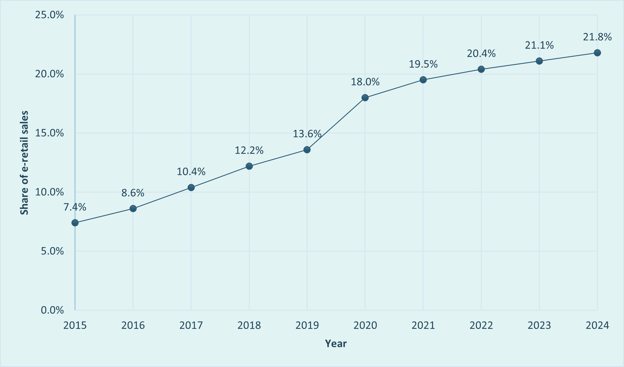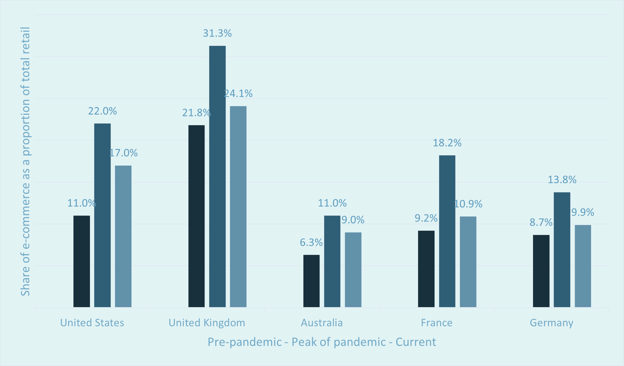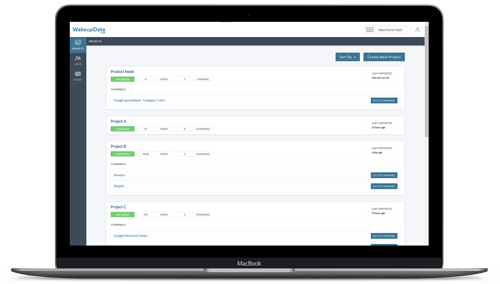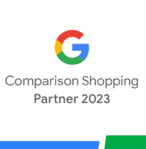Ecommerce Trends For 2022
Posted on November 4, 2021 (Last Updated: January 26, 2022)
We are currently experiencing business moving online. It may be thanks to the world pandemic situation, it may be due to technological developments or it may be just a natural process of business evolution. If we take a look at the numbers (figure below), we can see that the growth of the e-commerce industry is continuously accelerating.
During the Covid-19 pandemic, many companies were forced to move their business online. Some of them found the juicy fruits of e-commerce and kept focusing on online, even though the pandemic restrictions ended and it allowed them to get back to the offline.
In the figure above you can see the share of e-commerce sales as a proportion of total retail before, during, and after the pandemic by country (source Statista).
What trends are we supposed to expect in this rapidly growing online world?
Mobile Commerce
M-commerce is definitely the trend that should be at the very beginning of this blog post. The strength of smartphones and tablets is on rising and the popularity of shopping via phones. According to Statista, mobile commerce will have a 53.9% share in E-commerce in the U.S. by the end of 2021. It’s more than half of all purchases! Do you have your webshop optimized for AMP? If not, I would highly recommend you to put it as priority number one. M-commerce is all about speed. According to Ericsson’s studies, the cognitive functions and reactions while using a smartphone are at the same level as watching a horror movie or solving a math problem. That means customers are not willing to wait if your webshop is slow, but rather will satisfy their needs elsewhere.
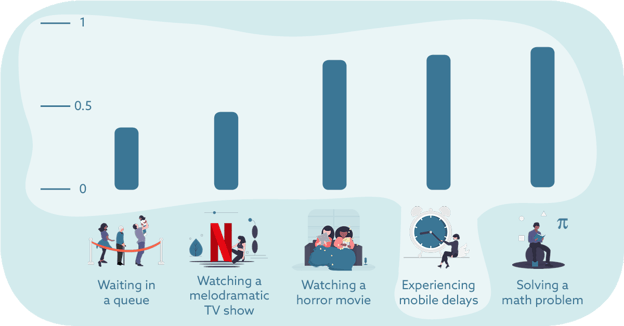
The figure above shows the level of stress caused by mobile delays compared to watching a horror movie or solving a math problem.
Diversity of Payment Methods
Customer’s satisfaction lies in the little things. Diversity of payment methods is one of them. It is the last step in the entire shopping process and the lack of preferred payment methods may cause a misfire. Allow customers to pay in the way they desire and keep things simple. Did you know that according to an Emarketer report more than 50% of all purchases will be made via a smartphone by 2025? ApplePay and GooglePay look like excellent solutions for this scenario.
Except for payment by credit card, bank transfer, PayPal, and others, there is a rising trend to purchase in installments. For example in middle Europe Twisto offers purchases for thirds. It means you can split the amount over three months. More services are available across Europe via different companies. It may benefit by gaining customers which couldn’t afford the products in casual circumstances.
PRO tip:
We have some ideas on how to improve your webshop and make everything simpler:
- Order in 1 click
- Fast check-out
- Offer popular payment methods
- Saving the user’s data
- Buying directly on the product page
- Offer installments
- Price and duration of delivery visible
Social Commerce
The next trend headed upward is the subset of e-commerce, often used by D2C (Direct to Consumer) companies, whose goal is to keep the whole shopping experience - finding the product, making the decision and check-out in one place. It has its own pros and cons. The majority of the pros are on the side of the consumer and that is important for the trend. Everything is happening on the social media platform (Facebook, Instagram, Pinterest, TikTok), where consumers have the opportunity to read the reviews of others or get in touch with the seller directly before they buy the product. Businesses, which enter social commerce are able to get into the everyday life of consumers, create stories, arouse emotions, and achieve valuable feedback. As a part of Social Commerce, there is a new trend coming called Live Shopping, which is described separately below.
You can read more about this topic in our blog post about Social Commerce.
![]()
To advertise products online it is necessary to have your Product Feed ready. Do you know how to manage and optimize your Product Feed for your Social or other eCommerce channels?
- Your product feed must contain all data in the right order, with the right description
- Your product feed must match the information you have on your website
- The image of the product must be optimized for the advertising (learn more about Image Transformations)
- The title of the product has to convey the core features while being very brief
- The price must match the one you have on the website, and must also be in the correct currency of the country of sale
Not an expert in Product Feed Management or just don't want to waste a time? Get a free demo of our WakeupData Connect or Actions and be guided through the process of getting your feed optimized and ready!
Omnichannel and Hyper-personalized Customer Experience
We already know that the number of users and potential customers on socials will be continuously increasing. But that doesn’t mean they will disappear from other places. Everyone prefers their own way of purchase and not everybody is comfortable with buying goods via social media. That’s why it is necessary to be seen in as many places as possible. Omnichannel is a method of selling that uses all the channels available, either online or offline. More places mean better reach, whether organic or paid.
![]()
Hyper-personalization allows businesses to provide the best customer experience. Gathering all the information about the customer from omnichannel makes an important asset the company can work with. It starts where the customer is facing the touchpoints, headlessly (CMS, TV, Watch, Native Apps, Social Commerce). After customers experience the storefronts, then the next step comes into play - the customer data solution. The information can be composed from surveys, customers’ actionable insights, offline visits in-store, data-privacy, consent management and other sources. AI will process the information given by the customer either online or offline and will create a Customer 360 profile. The final magic is happening in e-commerce applications. The information gathered by the business can be implemented in its e-commerce platform. The customer will experience it in online product catalogs, search, configurable products and promotions, cart, order management and all the places in omnichannel available, where the selections, options, pre-filled windows, will be adjusted to the customer’s profile.
We can expect an emphasis on hyper-personalization now and in the near future, since we are experiencing the transformation of the market to direct selling (D2C). Also, people don’t like to be targeted by a wide campaign but are more likely to buy a product if the advertised products and services are optimized to their needs.
Google Local Inventory Ads (LIA)
Google LIA is a novelty, which is spreading across Europe. It is a tool, which uses the customer's location to highlight products, which are available nearby. The principle of its marketing is simple. Users search for the wanted product on google and the in-store available products nearby will appear highlighted. Thanks to that, the customer has the opportunity to visit the store to check or try out the product before the purchase to avoid unnecessary complications (wrong size/color looks different than on the picture, etc.).
According to Google, consumers who have the possibility to see the product physically are more likely to buy it. As an addition merchants now can activate a pick-up later option.
If you want to dive into this topic, check out our blog post about Google LIA, or if you are ready to take the jump, book a meeting to learn more about Google LIA.
Cookies
What? Cookies as a trend? No, cookies themselves are not a trend, just a necessary part of the user’s data processing. But the way you offer options to users about which data you can process, which not and how you will do that is a key to building trust with the customer. Show users respect for their privacy and allow them to feel comfortable on your webshop. Understanding this method will help businesses build a brand’s good reputation and potentially gain long-term relationships with customers.
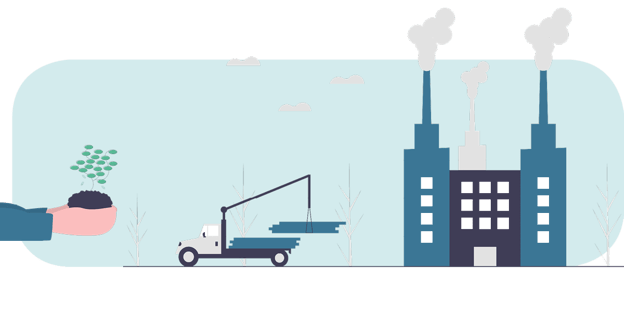
Sustainability
Sustainability has played a big role in the last few years and it has also entered the e-commerce industry. Due to packaging for delivering products to the customer, there is more waste produced. Consumers are more interested in products whose production, packaging and delivery process is sustainable. According to the European E-commerce report 2021 for all countries in the EU, customers are more likely to buy products that are made and delivered in a sustainable way. The difference between countries is at the point where the customers have to pay extra for that. Western and northern countries are willing to pay extra for sustainable products while other countries with lower GDP per capita are not. Anyways, the number of customers who are supporting sustainability in e-commerce is increasing year by year in every country. I can’t say if sustainability will be the trend of 2022, but it certainly has its importance in e-commerce and at the same time it is an attractive topic for a huge part of consumers.
POAS vs ROAS
To understand whether the advertisement is profitable or not, marketers usually use ROAS as an indicator (Return on Ad Spend). If the return from advertising is higher than the ad spend, then you’ve made money. It is a great metric. However, it does not cover all the metrics needed for Return in e-commerce analytics, which means Google, Facebook, Instagram and other marketing channels will not be able to tell if you have actually made money. So they decided to use Revenue instead of Return. That means that often ROAS stands for Revenue on Ad Spend. But Revenue doesn’t provide information about margin, fixed costs, payment fees, shipping costs, which are important indicators of prosperous e-commerce businesses. The ROAS has been perceived as the best practice so far if we talk about advertising profitability, and that’s because there wasn't a better metric for that.
POAS (Profit on Ad Spend) is an alternative to ROAS, which was originally meant to be short for Return on Ad Spend but ended up as Revenue on Ad Spend. To understand your POAS, you must divide the gross profit of the channel with the ad spend. If the result is higher than one, it means it’s profitable. Often, ad bidding strategies are based on targeting Breakeven ROAS (revenue), and that is untransparent. More expensive products are pushing target breakeven ROAS higher even though the margin is usually very low. In some cases, products with high margins, but lower-cost make up the biggest profit. Using POAS instead of ROAS will show you a transparent background of key indicators and enable you to bid effectively.
POAS is a gamechanger in Ad bidding strategy. If you want to know more about this metric or perhaps implement it in your business, get in touch or check out ProfitMetrics’ website where you can find valuable information from true professionals.
Also, you can read the whole blog post about POAS here.

Live Shopping and Visual Commerce
In both cases, we are talking about interactive methods of selling products online. Instead of static pictures on the internet, sellers offer realistic visuals that provide a clear picture of whether the product meets customers’ needs or not.
Live shopping can be part of Social Commerce since it can take place on social media platforms. It is based on the engagement of the customer with the seller or an influencer (as an ambassador of the promoted brand) who takes place in the live streaming. The promoter shows the product, its design and functionality and customers have the opportunity to ask questions. Additionally, as a part of the Livestream, there is a link to the webshop. The method of selling is very direct and quite new, so we can expect it to grow a lot in the first half of 2022.
Visual Commerce takes its place in eCommerce trends right after the live shopping. The goal is very similar, but the realization is a bit demanding. In visual commerce, customers can get an interactive 3D visualization of the product to have a better view and perhaps it can be part of the decision-making process. In the apparel industry, it will have a big role, since customers can virtually try out clothes, caps, glasses, and other accessories to have an idea if it fits them or not. It may take place on social media (TikTok) or on the website in an app designed and programmed by the brand.
